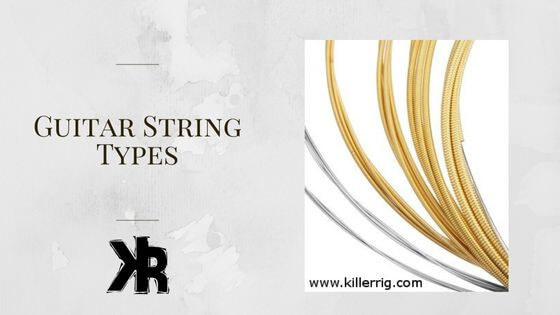Table of Contents
There are many guitar string types available, which can make it very hard to decide on what to use. But your choice of string has to not only be right for your play style, but your music as well.
Some instruments are designed only to use one kind, while others can use many. Then some brands seem to have different sound designs, feel, and other benefits.
In this Killer Rig article, we are going to look at the guitar string types to help you find the right ones for you. We will also look at their construction and materials. This will unlock tone from beneath your hands!
What are Guitar Strings Made of?
Manufacturers have made many types of strings that use different materials. They each have unique sound characteristics as well as service life. This can be difficult for a beginner when selecting a set that will be just right.
When it comes to strings for the electric, they need to be made from a material that is magnetic. In order for the pickups to work properly. Several materials are used for this purpose, each with its tone.
Most strings also have a material that wraps them. This is for longevity, playability, and sound. Sometimes these wraps are made from substances that are not magnetic. This also gives them their tonal characteristics.
Nickel Plated
Nickel-wound strings are the most popular type for electric guitars. They have a brighter, but balanced tone with a sharper mid-range attack. They are also the most common, so there are many brands to choose from.
Furthermore, they also lose their bright tone sooner than some others. They start nice and balanced, but after a few weeks of solid playtime, they begin to dull.
Ernie Ball makes some excellent string sets that are perfect for any player. Their regular slinky nickel wound set is great for 6, 7, or 8-string guitars. This set offers good tone and performance characteristics. If you are a more modern player, these are a great fit.
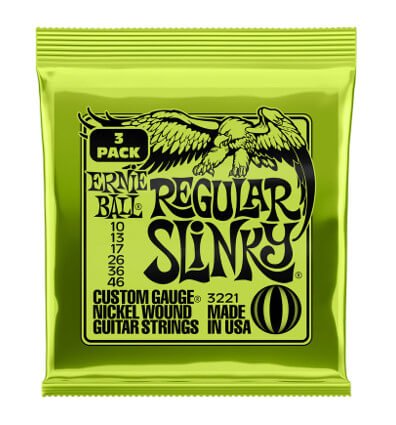
If you are a vintage player or an old-school rocker, then pure nickel strings would be a better fit.
Pure Nickel
Pure nickel strings are said to have a warmer tone than nickel-plated. They also have a more subtle attack and decay, making them ideal for vintage guitars.
Yet, they don’t lose their tone as fast as nickel-plated strings. They start with a broken-in, mellow tone and maintain it much longer.
Stainless
Stainless steel strings have a very bright and cutting tone. They are often used in rock and metal styles and have good sustain. They also have a long lifespan and are corrosion-resistant. Stainless strings are also great for anyone sensitive to nickel.
Titanium
Titanium strings are very bright with a lot of sustain. They are typically used for lead playing as well as shredding. They have a longer lifespan than some other types of materials, as titanium is very strong.
Chrome
Chrome strings are mellower than nickel-plated and have a smooth feel. They are warm with a round bottom end, which can be great for rock, blues, or jazz. They can also be great for rhythm and are available in many sizes.
Cobalt
Cobalt strings are very bright with good sustain and a punchy low end. They also have a stronger magnetic relationship with pickups. This gives them a more dynamic range.
Bronze and Brass Materials
Brass and Bronze string materials are used for acoustic guitars. The string itself is steel, but these materials are wrapped around it. They each provide a different response depending on their makeup. Here is what you can expect from these materials:
- Bronze strings have a bright and vibrant sound with great projection. They are also the longest-lasting type of string, but they can be harsh on your fingers. Made from 80% copper and 20% zinc, they oxidize fairly quickly and lose their brightness sooner.
- Phosphor-bronze are made with a phosphor coating to reduce oxidation. It maintains the brightness for a longer period. They have a warmer tone as a result of the phosphor, which is great for finger style playing.
- Aluminum bronze strings are also nice. They are a combination of aluminum and bronze. They have a bright tone with good projection and are ideal for strumming. A long lifespan and corrosion-resistant come along with them.
- Brass has a bright tone that stands out. They can be so cutting that they should only be used on full-bodied acoustic guitars. Otherwise, they tend to make smaller instruments sound very tinny. They have great projection and are perfect for darker-sounding models.
- Silk-and-steel strings create a softer touch that is easy on the fingers. They have a warm tone and are great for fingerstyle playing. They also last a long time and resist corrosion.
Nylon Strings
The classical guitar doesn’t have as many options as the others. They are quite different in build and material and are pretty unique. They do offer the same wrap design on heavier strings. It might consist of different materials.
| Nylon String Type | Response |
|---|---|
| Clear | Rich, warm and mellow |
| Black | Darker than clear, great for folk music |
| Synthetic gut | Warmer than clean, made for old world sounds |
| Silver plated copper | Bright tone, good projection |
String Construction
While different materials affect the sound and feel of guitar strings, so do the different shapes and cores. Here we will look at the many other options you need to consider besides the material.
String Core Shapes
We have mentioned the term winding several times so far. This is the construction of the thicker guitar strings.
Those that are wrapped with another material. Treble wire normally does not have this wrapping. Underneath this material is a steel core. It may come in two different shapes, hex-core strings and round.
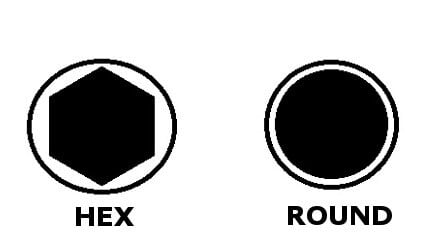
Each of the two cores has its benefits and weaknesses.
| Hex Core | Round Core |
|---|---|
| Brighter | Warmer |
| Stiffer | Flexible |
| Strong Attack | Softer Attack |
| Less Sustain | Longer Sustain |
| More Stable | Less Stable |
| Modern Sound | Vintage Sound |
Round cores are where it all started. As you can see, they have their issues. But are still highly sought after for their flexibility and tonal characteristics. Hex cores offer more stability and are the industry standard. This is because of all the additional benefits.
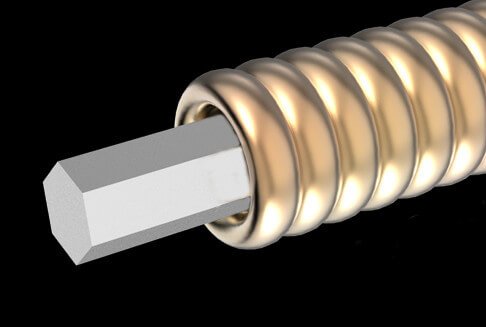
String Winding
Guitar strings also come with different windings. This is the material that wraps around the core of the string and can affect its tone, feel, and durability.
Round
Round wound strings have a winding made from round wire. They are the most popular because they have a bright tone, great sustain, and a long lifespan. They are flexible, but come with the price of greater fret wear and are rougher on your fingers,
Flat
Flat wound strings have a winding made from flat wire. They have a mellower tone than round wounds and are often used for jazz or country styles. They also provide a smooth feel, do less fret damage, and have a long lifespan.
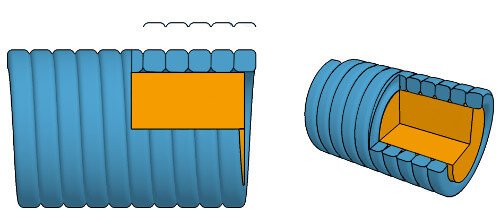
The downside to flat wound strings is that there is less sustain. They offer less grip and don’t sound as harmonically rich.
Half-Round
Half-round strings are a hybrid of round and flat wound. They have round windings on the outside and a flat winding on the inside. They offer the benefits of both types of strings, but at a higher cost.
While they are a mix of the two types. Sonically they are also all in the middle but are still darker than round wound strings.
String Ends
There are three types of string ends. Ball, loop, and tie-end. Each one plays an important role and is used in many guitar designs. Let’s take a look at the differences.

Ball Ends
Ball end strings have a small metal ball that fits into a hole in the bridge of the guitar. These ends, if not done right, can impact tuning stability. There are a few ways to make the loop around the ball, some better than others.
The ball is put onto the string end to secure it on the bridge of the guitar. This makes it fast and convenient to change strings without having to tie one end. And with steel, tieing a string would be disastrous for most players!
Loop Ends
Loop end strings have a small loop that goes over a metal post on the bridge of the guitar. This type of end is very popular because it is stable and does not put any extra tension on the string.
The downside to loop-ends is that they can be difficult to put on. If you don’t get them around the post just right, they can come off. A loop can also be made by taking the ball off of a string when in a pinch, or if you accidentally bought the wrong set.
Tie Ends
Tie end strings have a knot that is tied around the bridge post. This type is the most traditional and is very stable. You will normally see this with classical guitars and nylon.
The downside to tie-ends is that they can be difficult to put on and can come undone over time.
Which type of string you choose will depend on personal preference and the kind of guitar you are using. There are pros and cons to each, so it is important to try out different types to see what works better for you.
Thickness and Tension
Guitar strings also come in many different thicknesses. This allows a player to obtain a certain sound, but also a specific playability.
A thinner string will let players bend them easier than a thicker one. This is especially important for lead players, who need this slinky style for the best sound.
Rhythm players on the other hand seem to prefer a thicker string because they fit the tole better. You get a thicker tone, but also a certain feeling under your fingers. If you are a player who does double duty, then you will need a thickness that is somewhere in between.
Along with thickness comes tension. A thicker string will also be more tense. This is why they are harder to bend. But also why they sound the way they do.
Learn more about string gauge in our article here.
Guitar String Coatings
Guitar strings also come with different coatings. The Elixir string company introduced this technology in the 1990s, and it was an instant hit. This is a plastic polymer that coats the winding of the string. It’s to prevent corrosion from sweat, dirt, and other contaminants.
The benefit of coated guitar strings is that they last much longer. The corrosion resistance and support offered by the coating can extend string life. By over twice as long!
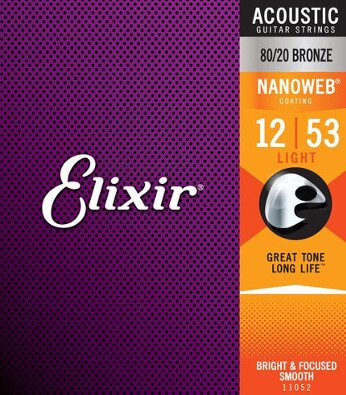
Elixir Strings
There are 2 different coatings offered by Elixir:
- Nanoweb: which is lighter and more like an uncoated string version.
- Polyweb: which is a heaver coating that affects sound and feel.
While coated strings seem to offer great benefits, there is a trade-off. One of the drawbacks is that the sound isn’t as bright and there is a loss of sustain. Plus, they are twice as expensive as uncoated strings.
If you have sweaty hands and go through strings very quickly, this might be a great solution.
Which type of guitar strings should You use?
When asking which guitar string type you should use, consider a few things. What music style do you play? Does it require a deep, thick tone? Then a heavier string might be best. Do you play a classical acoustic? Then you will need a warm-sounding nylon string.
There are many things that need to be considered when choosing a string type. The best way to decide is to try out a few different options. Consider which ones are best for what you need and go for them!
FAQs
Which guitar string material is best?
Steel strings are the most popular type and are usually made with nickel, bronze, or brass. They offer a bright tone and excellent volume. And depending on the core and wrap design, can also be very flexible and comfortable.
Nylon strings are typically made from gut, silk, or synthetic materials. They are used for classical and acoustic guitars. Nylon provides a warmer sound with more muted overtones than steel.
Are nickel strings better?
Nickel strings are not necessarily better than other types of materials. Yet, they do offer a few advantages. They have a bright tone, they are durable and long-lasting, and they are the most popular type of string.
Like most types, they do have corrosion issues. This could present itself much quicker than other materials. There are also wrap and pure nickel options. They provide different tones and performance characteristics.
What type of strings last the longest?
A thicker string tends to last longer. But the guitar must also be set up right and not have sharp ends anywhere. Coated strings are also a great choice when looking for longevity. This is because sweat and dirt can’t get in and create rust.
But generally, as long as you clean your strings and keep your guitar in good shape, they will last awhile. Even thinner ones can go the distance when properly cared for.

